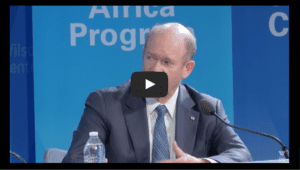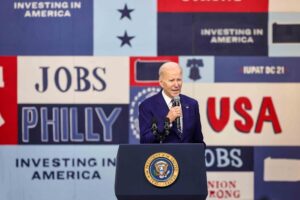Event Video: Senator Chris Coons on AGOA Reauthorization and Panel Discussion on the Future of US – Africa Trade and Investment
On June 18, WITA, in partnership with the Wilson Center Africa Program, hosted an event on the reauthorization of the African Growth and Opportunity Act (AGOA) and U.S- Africa trade and investment.
Featured Speaker and Opening Remarks:
Chris Coons, U.S. Senator, Delaware
Ambassador Mark A. Green, President & CEO, Wilson Center
Panel Discussion:
Florizelle Liser, President and CEO, Corporate Council on Africa
Kendra Gaither, President, US- Africa Business Center, US Chamber of Commerce
Patrick Utomi, Professor at the Lagos Business School
Sam duPont, Economic Policy Advisor, Office of U.S. Senator Chris Coons
Moderators:
Witney Schneidman, Senior International Advisor, Covington & Burling LLP; Member, Africa Program Advisory Council
Oge Onubogu, Director, Africa Program
06/18/2024 | Washington International Trade Association and the Wilson Center Africa Program
How the AGOA Reauthorization Process Could Help Diversify U.S. Critical Mineral Supplies
The United States is currently seeking to source the supplies of minerals and metals that are “critical” to support its clean energy transition and diversify the attendant supply chains away from geopolitical competitors. African countries have many of these critical minerals in abundance and already supply some of these resources to the United States. These countries also seek to attract investments in value addition for these commodities to support their industrialization objectives. There is scope to increase the aggregate minerals and metals trade between the United States and Africa both in terms of volume and composition by investing in the processing and refining of these commodities on the African continent, which will also reduce U.S. dependence on China. The African Growth and Opportunity Act (AGOA) provides an opening to achieve these objectives. Since September 2023, discussions have been underway—the AGOA midterm review at the African Union, the AGOA Forum in Johannesburg, as well as multiple briefings and symposia in Washington, DC—on the future of the trade program: the prospects of the legislation’s reauthorization before its expiry in 2025, enhancements around the program’s scope, and how to make it better attuned to the geopolitical realities of the 2020s.
The ongoing AGOA reauthorization process could facilitate the expansion of U.S.-Africa trade in critical minerals, which would be mutually beneficial for all parties. Such trade expansion could serve both the strategic interests of the United States, by diversifying the sources of critical minerals, as well as the economic interests of African countries by attracting investments in value chain development of these commodities. It could also demonstrate the U.S. commitment to shifting the U.S.-Africa relationship from one premised on aid arrangements to a twenty-first-century economic partnership.
As the reauthorization process proceeds, we draw on recommendations outlined in a recent Carnegie paper on how African countries can participate in U.S. clean energy supply chains to consider three options: (1) exempt eligible African mineral producers from Inflation Reduction Act (IRA) restrictions in order to diversify U.S. supply chains and advance African value-addition objectives, (2) reframe the U.S.-Africa trade relationship into a strategic economic partnership for a new era, and (3) negotiate a new critical minerals agreement (CMA).
Read the Full Policy Outlook Here
04/30/2024 | Zainab Usman & Alexander Csanadi | Carnegie Endowment for International Peace
The EU Chooses Engagement, Not Confrontation, in Its EV Dispute With China
The European Commission’s decision to impose new provisional tariffs on electric vehicles (EVs) imported from China came after nine months of investigation into China’s practice of subsidizing EV exports. Three Chinese producers were hit with three different anti-subsidy duties; BYD was hit with 17.1 percent; Geely, 20 percent; and SAIC, 38.1 percent. But the tariffs should be seen as the beginning of a process, not the end. A careful look at the European Union’s actions indicates its lack of desire to escalate trade tensions for political reasons and perhaps even willingness to find a negotiated settlement with China.
In addition to the three EV manufacturers mentioned, other EV producers in China that cooperated with the EU investigators received a weighted average duty of 21 percent. All other producers that did not cooperate were hit with the top 38.1 percent. These anti-subsidy duties come on top of the European Union’s regular 10 percent tariff on EV imports from China.
These new EU anti-subsidy tariffs are on par with those imposed following previous EU anti-subsidy investigations concerning imported goods from China. Rhodium Group estimates that collaborating Chinese firms in earlier investigations have faced new duties of an average of 19.7 percent. Meanwhile, in earlier EU anti-subsidy investigations, the exports of non-cooperating firms, such as coated organic steel products, received new duties of 44.7 percent, while Chinese exported truck and bus tires to the European Union in some cases were subjected to new duties of over 50 percent.
06/17/2024 | Jacob Funk Kirkegaard | Peterson Institute for International Economics
Can the U.S. Curb Chinese Production of EVs in Mexico?
Following are excerpts from commentary by six experts featured in The Dialogue.
Each were asked “how significant is investment from Chinese electric vehicle makers in Mexico? How likely is Mexico to ramp-up incentives for Chinese automakers to invest in Mexico? How can Mexico continue to attract foreign investment from China while maintaining good relations with the United States?”
Larry B. Pascal and Carlos Alva, members of the International Practice Group at Haynes and Boone:
“Putting aside incentives, in theory, a Chinese automaker could open a plant in Mexico without the intent to qualify for national origin treatment under the USMCA (and by implication without an immediate intent to export to the United States) and instead focus on the domestic Mexican market or those other foreign markets for which Mexico has a free trade agreement.”
José Carlos Espinosa, head of sales at LGS International:
“If Mexico perceives that maintaining good relations with the United States is paramount, it may adjust its incentives and policies accordingly. To continue attracting foreign investment from China while maintaining good relations with the United States, Mexico could pursue several strategies: diplomatic engagement, open communication, diversification of investments, transparency and fair trade practices, emphasis on shared goals, and investment incentives based on criteria.”
Margaret Myers, director of the Asia & Latin America Program at the Inter-American Dialogue:
“For the United States, the problem is bigger than Chinese efforts to take advantage of USMCA provisions. Whether Mexico provides incentives for Chinese companies or not, Chinese companies are well-positioned to carve out increasingly dominant positions in all sorts of high-end industries. Mexico is an important destination for many, as is much of the rest of the Latin American region.”
Lucinda Vargas, associate director of the Center for Border Economic Development at New Mexico State University:
“Could its Mexican production platform eventually contemplate generating an electric vehicle for the U.S. market under the USMCA? Yes, but the rules may change. USMCA rules stipulate a 75 percent North American content on automotive products for duty-free U.S. entry. In the USMCA’s review in 2026, stricter rules could be entertained to stipulate that of the remaining 25 percent of content in an automotive product, zero percent can be associated with a ‘foreign entity of concern,’ that is, China as labeled by the U.S. government.”
Diana Avalos Morales, executive director of the Mexican Association for Electric Vehicle Promotion:
“To continue attracting investment from China while maintaining a fair trade relationship within the USMCA, Mexico should pursue a transparent regulatory framework to ensure unfair practices are avoided. This approach could mitigate concerns about tariff evasions while fostering economic partnerships that are beneficial for all countries involved. Mexico is keen on further developing its national supply chain to transform the country from a very vehicle assembly-oriented manpower to a country that supplies complete products to the market.”
05/17/2024 | Carlos Alva, José Carlos Espinosa, Diana Avalos Morales, Margaret Myers, Larry B. Pascal & Lucinda Vargas | The Dialogue
International Trade Policy Under Biden: The “New” Washington Consensus and Its Discontents
After four years of President Trump’s slash-and-burn trade policy, the bar for the incoming Biden administration could hardly have been lower. Trump’s “America First” bravado was an ungainly amalgam of tax hikes (against foes and friends alike), bilateral power plays (for example, Trump ordered the “renegotiation” of the Korea-US Free Trade Agreement [KORUS], otherwise threatening termination of what he termed “a horrible deal”), and a retreat from international trade cooperation (among others, spurning the megaregional Trans-Pacific Partnership [TPP] and undermining the World Trade Organization [WTO]). Trump’s trade policies not only ruffled the feathers of many of America’s closest trade partners, but they were also economically ineffective. Notably, they failed to benefit even those sectors and locations that his tariffs were supposed to protect. Ironically, the Trump tariffs did not change China’s behavior one bit.
A “New” Washington Consensus
It came as no small surprise when President Biden, despite calling Trump’s trade actions “disastrous” and “reckless,” not only failed to repudiate those policies, but actually amplified them. This is not to say that Trump’s and Biden’s versions of economic nationalism are equivalent. Trump’s style was all sticks and no carrots—belligerent, scattershot, and ad hoc. Biden’s version, albeit no less fervent, is soft-footed and polite—more carrots than sticks; commentators have called it “polite protectionism” or “pragmatic unilateralism.” Most notably, Biden provides a coherent intellectual superstructure that ties his administration’s trade policy to its overall international economic strategy.
In a scarcely noticed but consequential speech in July 2023, National Security Advisor Jake Sullivan outlined the Biden administration’s economic ideology. Sullivan blamed the United States’ most pressing challenges—namely, a hollowed-out industrial manufacturing base, dramatic economic inequality between rich and poor and between coast and heartland, the economic and military rise of China, and the climate crisis—on a number of factors including hyperglobalization, unfettered deregulation, naive beliefs in trickle-down economics and market efficiency, and trade liberalization as an end in itself. Drawing a sharp contrast to the 1990s-era policy package known as the “Washington Consensus”—championed by the US Treasury, IMF, and World Bank—that according to Sullivan encapsulates the idolatry of free markets and liberalized trade, he declared that the Biden administration stood for a “New Washington Consensus.” To address the above-mentioned challenges, the administration’s novel paradigm is aimed at achieving supply-chain resilience in strategically important sectors, a return to former manufacturing grandeur, more equitable growth that benefits American workers, rapid decarbonization and a successful transition to green technologies, and a containment of China’s military and economic might.
Few Americans would disagree that these are worthy goals. It is, however, the implementation of these goals that warrants scrutiny…
Read the Full Policy Brief Here
06/19/2024 | Simon Schropp | Mercatus Center
WITA – We put the community in trade community.
Information about upcoming WITA and trade community events






